|
The
Art of Everyman
by
Bob Brooke
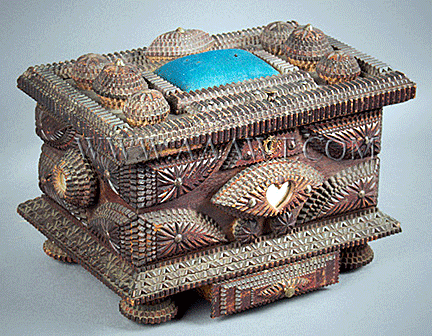 Tramp
Art was an art movement found throughout the world in which mostly men
whittled small pieces of wood, primarily from discarded cigar boxes and
shipping crates, into layers of geometric shapes having the outside
edges of each layer notch carved. It was popular from the 1870s to the
1940s when the art form began to decline. Tramp
Art was an art movement found throughout the world in which mostly men
whittled small pieces of wood, primarily from discarded cigar boxes and
shipping crates, into layers of geometric shapes having the outside
edges of each layer notch carved. It was popular from the 1870s to the
1940s when the art form began to decline.
These primitive artists used simple tools such as a pocketknife to carve
the wood and assemble mostly utilitarian objects. Though tramp art
pieces were abundant throughout the world, the movement prospered in the
United States. The most common forms were the box and the frame and
although there were no rules or patterns to lend commonality in the
artists’ work there were objects made in every conceivable shape and
size including jewelry boxes, sewing caddies, full sized furniture, and
objects of whimsy.
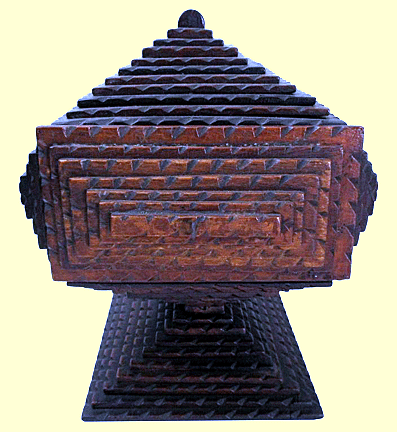 Tramp
Art was a democratic art form since artists constructed their pieces
from found raw materials. In the U.S. alone there were over 50 different
ethnic groups who made it. It appealed to men who might have made one
piece in their lifetime or to those who might have made an important
body of work such as ‘Sunflower’ artist John Martin Zubersky, active
from 1912 to 1920, or the wonderfully expressive wall pockets by John
Zadzora, active around 1910. It was easy to make and appealed to anyone
who had a desire to take a pocketknife to wood. Tramp
Art was a democratic art form since artists constructed their pieces
from found raw materials. In the U.S. alone there were over 50 different
ethnic groups who made it. It appealed to men who might have made one
piece in their lifetime or to those who might have made an important
body of work such as ‘Sunflower’ artist John Martin Zubersky, active
from 1912 to 1920, or the wonderfully expressive wall pockets by John
Zadzora, active around 1910. It was easy to make and appealed to anyone
who had a desire to take a pocketknife to wood.
Countless men, some women, and even children constructed tramp art.
Tramp art at home, but factory workers, farmers, and others in every
conceivable occupation also created it. Although there were tramps or
hoboes who made pieces, they weren’t the primary group as the name
suggests. Francis Lichten invented the name tramp art in Pennsylvania
Folk Life Magazine in 1959, but it had nothing to do with the art form.
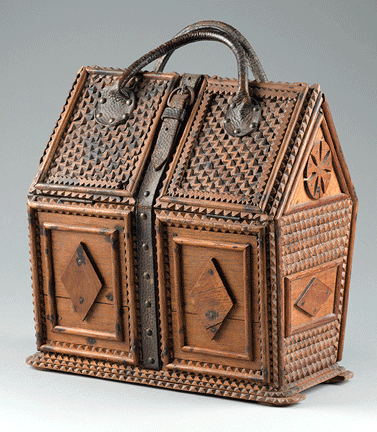 The
stories of this art form became the facts while the misconceptions
became the truths. There were no rules for constructing the pieces.
Materials were whatever the carver could find. Decorations were whatever
he could produce or had available. Within the context of his own
imagination, experience, and abilities, the carver assimilated what he
saw with what he had to work with. He then translated and created what
he saw into works of art by using his pocketknife and the ever-present
cigar box. The
stories of this art form became the facts while the misconceptions
became the truths. There were no rules for constructing the pieces.
Materials were whatever the carver could find. Decorations were whatever
he could produce or had available. Within the context of his own
imagination, experience, and abilities, the carver assimilated what he
saw with what he had to work with. He then translated and created what
he saw into works of art by using his pocketknife and the ever-present
cigar box.
Tramp Art can be compared to quilts. People constructed both from
salvaged materials, cut into patterns of primarily geometric shapes
pieced together, and layered to create utilitarian objects. Both
traditions could be done in the company of others with the “how-to”
passed on orally.
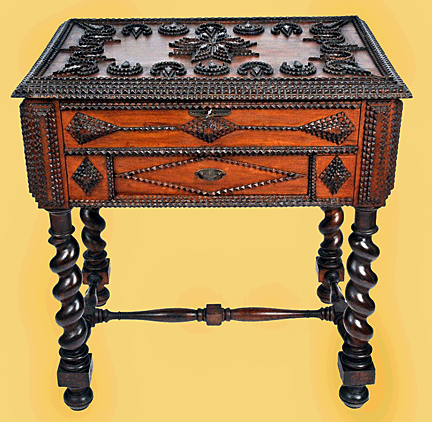 Unfortunately,
historians know little of tramp art’s history since there were few
references to it as an art form. Most of the early perceptions came
about because early scholars were at a loss to explain this unique art
form. Early folk art experts believed that the poor, displaced and
unschooled artisan made most of the pure folk art,. Even today the study
of folk art celebrates the romantic myth of the folk artisan on the
outside of convention and on the outside of society. Unfortunately,
historians know little of tramp art’s history since there were few
references to it as an art form. Most of the early perceptions came
about because early scholars were at a loss to explain this unique art
form. Early folk art experts believed that the poor, displaced and
unschooled artisan made most of the pure folk art,. Even today the study
of folk art celebrates the romantic myth of the folk artisan on the
outside of convention and on the outside of society.
Since the 1960s, folk art experts have discovered hundreds of men, some
women, and even children who made tramp art. And it was one of the first
artistic movements to use discarded materials to make objects of art as
well as utilitarian objects for everyday use.
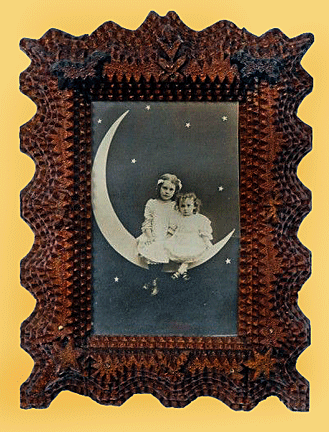 There’s
a great deal of proof that tramp art wasn’t made by tramps exclusively
as the name suggests. There are only a couple of documented makers out
of the hundreds who were truly itinerant. Based on the artists’
background or profession, the movement could more likely be called
Farmer’s Art or Baker’s Art, or any other occupation practiced during
tramp art’s years of production. All would be far more authentic than
the term tramp art. It was the art of “everyman.” It appealed to anyone
who had the desire to take discarded materials to make art. The mostly
unschooled makers created it in their homes far from the art schools or
workshops of high art. There’s
a great deal of proof that tramp art wasn’t made by tramps exclusively
as the name suggests. There are only a couple of documented makers out
of the hundreds who were truly itinerant. Based on the artists’
background or profession, the movement could more likely be called
Farmer’s Art or Baker’s Art, or any other occupation practiced during
tramp art’s years of production. All would be far more authentic than
the term tramp art. It was the art of “everyman.” It appealed to anyone
who had the desire to take discarded materials to make art. The mostly
unschooled makers created it in their homes far from the art schools or
workshops of high art.
No one really knows where tramp art originated. It seemed to appear
everywhere at the same time. There are few tramp art objects that show
evidence of woodworking ability. It does not seem probable that
professional woodworkers had any influence or spread the art form.
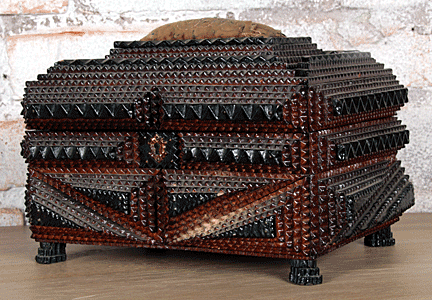 The
technique of chip carving consisted of notching and layering, with each
succeeding layer being a little smaller than the preceding one, to
create a pyramidal design. One cigar box or many cigar boxes could be
used for the frame of the piece as well as performing the decorative
function. Either way, the carver had to have a great deal of time and
patience to create his finished product. He had to notch-carve each
individual piece of wood many times. Then he had to layer the individual
notch-carved pieces of wood into some kind of recognizable object. And
then he had to decide if he wanted to add further decorations to the
piece. One of the most fascinating characteristics of tramp art is the
desire of the carver to produce detailed and often very skilled work
with only make-do and simple tools. He layered piece upon piece for
strictly decorative purposes, because he felt that many layers of wood
were more interesting looking than just one. The
technique of chip carving consisted of notching and layering, with each
succeeding layer being a little smaller than the preceding one, to
create a pyramidal design. One cigar box or many cigar boxes could be
used for the frame of the piece as well as performing the decorative
function. Either way, the carver had to have a great deal of time and
patience to create his finished product. He had to notch-carve each
individual piece of wood many times. Then he had to layer the individual
notch-carved pieces of wood into some kind of recognizable object. And
then he had to decide if he wanted to add further decorations to the
piece. One of the most fascinating characteristics of tramp art is the
desire of the carver to produce detailed and often very skilled work
with only make-do and simple tools. He layered piece upon piece for
strictly decorative purposes, because he felt that many layers of wood
were more interesting looking than just one.
In addition to chip carving and layering, applied and inlaid decorations
were another common technique used in Tramp Art. Since geometric
patterns of circles, squares, and triangles were the easiest to carve,
they were the most common type of applied and inlaid decoration. Hearts
and stars were the most-used symbols for such decorations, and sometimes
the entire object would be made into a heart shape.
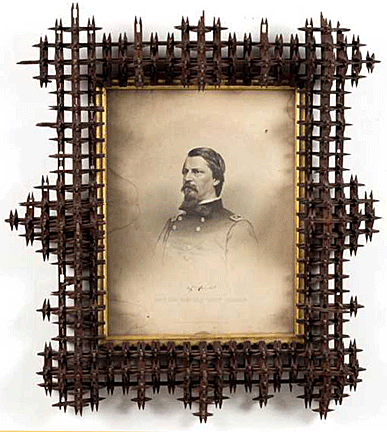 Another
type of tramp art wasn’t quite as popular as the traditional layering
and chip carving. This is often referred to as the "crown of thorns."
Artists made pieces in a layering pieces of cigar-box wood. They notched
the pieces of wood together in an interlocking and overlapping fashion
as logs overlap in building a log cabin. As they interlocked the pieces,
they also layered them and built them up like vertebrae to form a star
effect. Another
type of tramp art wasn’t quite as popular as the traditional layering
and chip carving. This is often referred to as the "crown of thorns."
Artists made pieces in a layering pieces of cigar-box wood. They notched
the pieces of wood together in an interlocking and overlapping fashion
as logs overlap in building a log cabin. As they interlocked the pieces,
they also layered them and built them up like vertebrae to form a star
effect.
Tramp art became a very popular art form because it allowed the artists
to use the materials they had at hand to produce a great variety of
objects. He created picture frames, gift and jewelry boxes, and
full-size chests of drawers not only to fill his empty hours, but so
that he could use them as gifts for friends, barter for food, or in
exchange for money.
<
Back to Antiques Archives
Next Article > |
